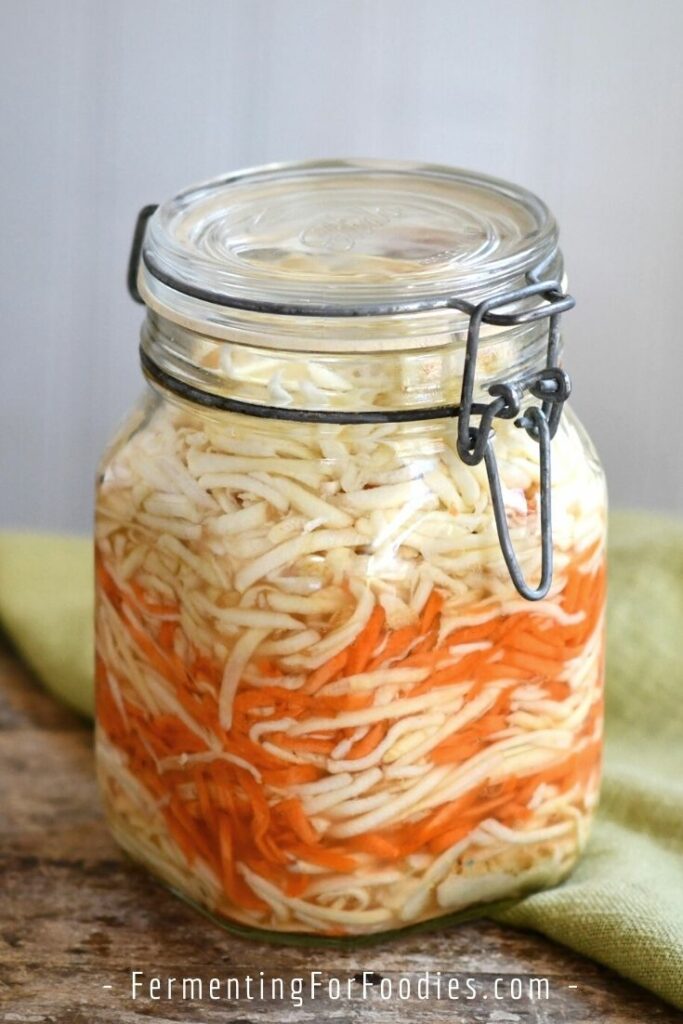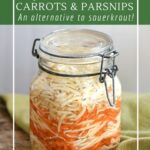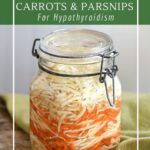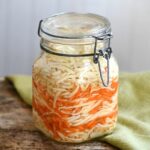This alternative sauerkraut is a cabbage-free version for anyone with food sensitivities or hypothyroidism. It’s made with non-brassica vegetables like carrots and parsnips.

Wondering why anyone would be interested in a cabbage-free sauerkraut? The point of sauerkraut is that it’s a traditional cabbage ferment! Sauerkraut = cabbage!
The inspiration for this post came from a reader who was looking for a cabbage-free alternative to sauerkraut. They wanted the flavor and style of kraut, just not the cabbage. That’s because not everyone can enjoy cabbage or other brassicas (vegetables from the same family as cabbage, like broccoli, cauliflower, and turnips). For that reader, brassicas caused a lot of indigestion.
In my case, I have hypothyroidism. It’s long been known that eating a lot of brassicas can reduce thyroid functioning. Cooking reduces goitrin (the compound that inhibits thyroid functioning), fermenting does not. So creating a cabbage-free sauerkraut is certainly something I’m interested in!
I decided to make this recipe with a combination of carrots and parsnips. They’re both similar enough to cabbage to provide the natural sweetness and flavor, without treading into the realm of being from the cabbage family.
It’s also perfect for serving in the place of sauerkraut.
Flavor Options
Like sauerkraut, this fermented condiment is perfect for all sorts of different flavors. Feel free to use any of recommended sauerkraut flavors.
Here are a few combinations that work really well:
- Traditional: 1 tsp caraway seed, 1 tsp mustard seed, and 10 juniper berries.
- Pepper: 2 bay leaves and 5 black peppercorns.
- Curry: Add 1 finely diced onion and 2 tsp of mixed Indian curry spice with the salt.
- Dill pickle: 1 tsp dill seed and 1 finely diced clove of garlic.
- Spicy: Add in 1 finely diced hot pepper
- South American: For a curtido-like condiment, add 1 finely diced onion, 1 finely diced hot pepper, and 1 Tbsp of oregano.

Alternative Sauerkraut
This alternative sauerkraut is a cabbage-free version for anyone with food sensitivities or hypothyroidism. It’s made with non-brassica vegetables like carrots and parsnips.
- Prep Time: 15 minutes
- Total Time: 15 minutes
- Yield: 1-quart 1x
- Category: Condiment
- Method: Fermented
- Diet: Vegan
Ingredients
- 2 medium-sized parsnips
- 2 large carrots
- 1 Tbsp pickling salt
- Flavors (see section above for 6 options)
- 1 cup of chlorine-free water
Instructions
- If the parsnips are really gnarly, peel them. Otherwise, it’s fine to leave the skin on. Grate the parsnips and carrots. You want enough grated vegetables to fill a quart-sized (1 L) jar, so adjust the number of vegetables depending on the sizes. I usually start with the 2 carrots and 1 parsnip, then grate more as needed.
- Toss the grated vegetables in a bowl with the salt and any additional flavors. Leave them to soften for 10 minutes, which will make it easier to pack them into the jar.
- Pack the mixture into a 1-quart (1L) jar leaving at least 1 inch of headroom for bubbling. Use a spoon to really press the vegetables into the jar. You may need to add a bit more carrot or parsnip depending on the sizes of your vegetables. It’s fine to top off the jar with more grated vegetables that haven’t been tossed with salt. The brine will cover them as well.
- Add the water and press the vegetables again. They may not be completely covered by the brine, however, they will probably soften and release liquid within 24 hours. Use a weight to keep everything under the brine, and cap with a lid that will release CO2 as it ferments. If you are new to fermenting, here’s a post on the different types of jars for fermentation.
- Place the jar somewhere cool and dark to ferment, a kitchen cupboard is perfect. It will bubble rapidly for the first week. Feel free to enjoy it fresh and sweet (after 3 days of fermentation) or when it is a bit more sour.
Notes
- It’s fine to replace some of the parsnips and carrots with other non-brassica root vegetables, like beets and celeriac.
- If you are new to fermenting and want to store this ferment at room temperature for longer than a week, I recommend reading my post on how to ferment vegetables for details on the best practice for fermenting vegetables.
Nutrition
- Serving Size: 2 Tbsp
- Calories: 10
- Sugar: 0.8g
- Sodium: 186 mg
- Fat: 0
- Carbohydrates: 2.3g (will depend on length of fermentation)
- Fiber: 0.6
- Protein: 0.2



Leave a Reply